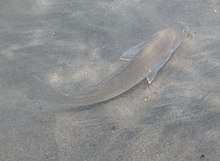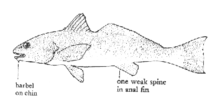California corbina
| California corbina | |
|---|---|
| Scientific classification | |
| Kingdom: | Animalia |
| Phylum: | Chordata |
| Class: | Actinopterygii |
| Order: | Perciformes |
| Family: | Sciaenidae |
| Genus: | Menticirrhus |
| Species: | M. undulatus |
| Binomial name | |
| Menticirrhus undulatus (Girard, 1854) | |


The California corbina (Menticirrhus undulatus) is marine demersal fish in the croaker family. It can often be found along sandy beaches and in shallow bays. This species travels in small groups along the surf zone in a few inches of water to depths of 20 meters (66 ft). Other names include "California kingcroaker," "California whiting," and "kingfish".
Description
California corbina are uniformly grey in color with some iridescence and have an elongated and slightly compressed body shape in comparison to other croakers.[1][2] Like all members of the genus Menticirrhus, the California corbina lacks a swim bladder and is unable to produce a croaking sound.[2][3] It is believed that the loss of the swim bladder evolved to facilitate living in a turbulent environment.[3] This species and the yellowfin croaker are the only two of the eight coastal croakers found in California waters to exhibit a single barbel on the lower jaw.[1] The California corbina's barbel is short and stiff and is used to detect prey.[2][3] The upper half of the caudal fin has a concave trailing edge, while the lower half trailing edge is convex.[1] The largest recorded specimen was 28 inches (710 mm) and 8.5 pounds.[1][2]
Distribution and habitat
California corbina is reported to occur from the Gulf of California, Mexico, to Point Conception, California.[1][2] However, the IUCN questions the extent of the California corbina's southern range due to the presence of similar and easily misidentified species that exist in the Gulf of California.[4]
California corbina are commonly found in the surf of sandy beaches and shallow bays up to a depth of 20 meters (66 ft).[1][4] California corbina are often found in small groups, however, adults have been observed traveling solitarily as well.[2]
Ecology
Diet
The California corbina's diet consists of crustaceans, small fish, bivalves, and other small invertebrates.[5] California corbina have been observed feeding in just a few inches of water in the upper surf.[1] To feed, they scoop up mouthfuls of sand and separate the food by expelling the sand through the gills and spitting out bits of clam shells and other foreign matter.[1]
Life cycle
Males mature at approximately 2 years of age and a length of about 10 inches and females at age 3 and about 13 inches in length.[1] Spawning extends from June to September, but is heaviest during July and August.[1] The eggs are free floating.[1] Population size, recruitment, and mortality of this species is currently unknown.[4]
Fisheries
The California corbina is targeted by commercial and sport fisheries.[4] California corbina may be caught throughout the year, but fishing reaches its peak in summer and late fall.[4] Due to the fact that California corbina live nearshore, they are most often caught by fisherman on beaches, piers, and jetties; not on private boats or fishing vessels.[4] This species is occasionally caught as by-catch by shrimp trawling vessels.[4]
Conservation status
The IUCN has assessed the California corbina as data deficient due to outstanding questions about the species' distribution.[4] There are no known conservation efforts that specifically target the California corbina, however, part of its distribution is protected by various marine protected areas.[4] There has been a decline in catch since the early 2000's, but it is not known if this reflects a decline in population.[4]
References
- 1 2 3 4 5 6 7 8 9 10 11 "Marine Sportfish Identification -- Croakers Group". 2007-02-08. Retrieved 2018-08-28.
- 1 2 3 4 5 6 N., Eschmeyer, William (1983). A field guide to Pacific Coast fishes of North America : from the Gulf of Alaska to Baja, California. Herald, Earl Stannard. Boston: Houghton Mifflin. ISBN 0395331889. OCLC 8668331.
- 1 2 3 Allen, Larry G.; Pondella, Daniel J.; Horn, Michael H. (2006). The Ecology of Marine Fishes: California and Adjacent Waters. University of California Press. ISBN 9780520246539.
- 1 2 3 4 5 6 7 8 9 10 "Menticirrhus undulatus (California corbina, California kingcroaker, Corbina, Kingfish)". www.iucnredlist.org. Retrieved 2018-08-28.
- ↑ Bocanegra Castillo, Noemí; Abitia Cárdenas, L. Andrés; Galván Magaña, Felipe (2000). "Espectro alimentario de la berrugata californiana Menticirrhus undulatus de laguna ojo de liebre, Baja California Sur, México". Ciencias Marinas. 26 (4). ISSN 0185-3880.